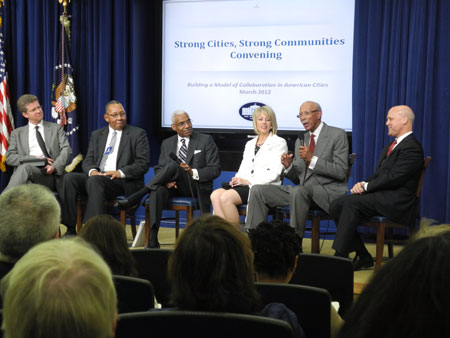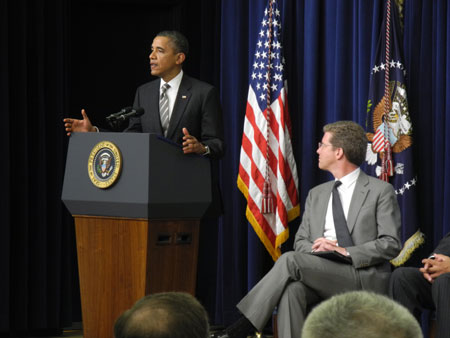IN THIS ISSUE:
President Obama Announces White House Council on SC2
Memphis: Create, Grow, Invest, Advance
By Sarah Ray, Team Lead
SC2 Community Solutions Teams
President Obama Announces White House Council on SC2
March 15 was a historic day for the Strong Cities, Strong Communities initiative (SC2), a partnership between the White House and 14 federal agencies aimed at breaking down federal silos and helping cities facing long-term challenges build capacity and more effectively use federal funds. The White House SC2 Convening featured panel conversations and roundtables with mayors of pilot cities and philanthropic, nonprofit, and business leaders. Most significantly, President Barack Obama made a surprise appearance to reiterate his support for SC2 and announced the signing of an Executive Order establishing a White House council to manage and further the initiative.
Following welcome remarks from Director of the White House Domestic Policy Council Cecilia Muñoz, HUD Deputy Assistant Secretary for Policy Development Erika Poethig delivered a presentation outlining the scope of the SC2 initiative:
- Community Solutions Teams, interagency groups of federal employees that work in 6 pilot locations—Fresno; Detroit; Memphis; New Orleans; the Northeast Ohio region of Cleveland and Youngstown; and Chester, Pennsylvania—to assist in implementing priority projects identified by mayors and other local leaders.
- The Economic Visioning Challenge, a series of competitions in which six selected cities will work closely with the Economic Development Administration to offer cash rewards for new solutions for strategic economic transition planning.
- The Fellowship Program, which will provide the SC2 pilot cities with a class of highly skilled fellows who will become the next generation of local leaders and is funded by a $2.5 million donation from the Rockefeller Foundation.
- The National Resource Network, which will extend SC2’s reach beyond the pilot cities by offering short-term, place-based engagements with expert technical assistance providers to eligible local governments in distressed communities.

Pictured from left to right: Secretary Donovan, Mayor Linder (Chester), Mayor Wharton (Memphis), Mayor Swearengin (Fresno), Mayor Bing (Detroit), and Mayor Landrieu (New Orleans).
HUD Secretary Shaun Donovan led a mayor’s panel on key challenges facing cities with Detroit’s Dave Bing, New Orleans’ Mitch Landrieu, Chester’s John Linder, Fresno’s Ashley Swearengin, and Memphis’ AC Wharton. The mayors praised the effects of the initiative. Landrieu, for example, described SC2 as a new way to improve vertical and horizontal integration across governments and a response to frustration by people of all political parties at inefficient government processes.
Discussing major problems their cities were confronting, all mayors cited violence and employment as central, interconnected concerns. As Linder explained, “crime is the absence of a response,” and well-developed economic development strategies are necessary to create opportunities for young adults and reduce the desperation that leads to crime. Wharton spoke to the need to match resources and services between governments, and explained that the Community Solutions Team brings fresh approaches and best practices that can come with a national perspective.
As Donovan opened the session to audience questions, President Obama appeared to great surprise and applause. The president underscored how important he believes the SC2 effort is: “We’re living in a time of limited resources,” he said, “…and yet need continues to be enormous. And so the question is, how do we consistently get more bang for our buck?” President Obama called himself a “fierce advocate on behalf of cities and metropolitan areas,” and cited the necessity of cities, suburbs, and rural areas to work together regionally to be competitive. He praised the mayors in attendance, and announced the establishment of the White House Council on Strong Cities, Strong Communities via Executive Order, which will build on the early successes of the SC2 model.
A subsequent panel on aligning private, philanthropic, and public-sector collaboration discussed what made collaboration successful. Annie E. Casey Foundation Associate Director Scott Spencer explained that leadership was critical, and that philanthropy gets involved in projects when there is a driving force that inspires investment. Mayor Chris Coleman, of St. Paul, noted the need for cities to think beyond their immediate regions, as business recruitment is now global in nature.
Upon the panel’s conclusion, the event’s participants split into groups for four roundtable discussions, focused on: finding and retaining talent; developing an economic vision; creating greater efficiency and innovative service delivery; and the role of community development financial institutions and capital development in community building.
In the talent conversation, Donna Vaillancourt, the Human Resources Director for San Mateo County, California, highlighted some of the challenges in attracting young talent to government work, as well as workforce development strategies that the county has used to overcome these barriers. Such strategies included a high school and college internship program to expose students to government, and a program for detailing existing employees to other county agencies to build new skills. And Max Stier, the president and CEO of the Partnership for Public Service, discussed strategies for improving government hiring. He suggested that governments should develop good metrics to understand whether or not current recruitment and retention strategies are working, establish strong networks to help develop and encourage new workers, and tap into retirees that might return to teach current workers, among other advice.

Participants in the economic visioning roundtable focused on the need for regions to innovate in the manufacturing and service sectors, to tap global markets, and to engage in the emerging energy efficiency sector. Amy Liu, senior fellow at the Brookings Institution, discussed the confusion that can emerge when regions have too many plans, and the need to prioritize strategies and develop a unified economic development plan. CEO of Collaborative Economics Dough Henton emphasized the role of data in economic visioning, but also insisted that planning is meaningless without leaders with strong implementation skills.
The efficiency and service delivery group had a wide-ranging conversation about how improvements to operational efficiency and the use of technology have helped local governments make progress toward their visions, as well as how philanthropy and business have supported such efforts. For example, David Eichenthal, senior management consultant at Public Financial Management, spoke to how cities can apply information from 311 systems to develop business intelligence and link back to monitoring performance. New York City Chief Digital Officer Rachel Sterne discussed the city’s open government initiatives, and has engaged partners in developing apps that help make city operations safer and more efficient.
Finally, the community development financial institution (CDFI) and capital development roundtable discussed how distressed communities, such as the SC2 sites, can access and deploy capital effectively. The meeting revealed that local capacity in many forms was often missing, hindering a vibrant CDFI market. To solve this challenge, many cities have imported expertise by either having a large CDFI expand its coverage area or contracting with specialists from outside organizations for a limited period. Another major topic was the role of larger institutions and the public sector: philanthropic funders can invest to build capacity or pools of capital; anchor institutions have substantial procurement power that they can use to source locally through emergent and small business; and the government—municipal, state, and federal—can coordinate and sequence funds in a much more effective manner.
The convening served as both a culmination of two years of program development and implementation and a launching pad into the initiative’s next phase, including the institutionalization of this new federal approach for cities through the SC2 Council. With President Obama’s mandate to think in new ways about partnership and better serving America’s communities, those engaged in SC2—both inside and beyond government—left committed to developing models that can help put local economies on stronger, more resilient footing.

